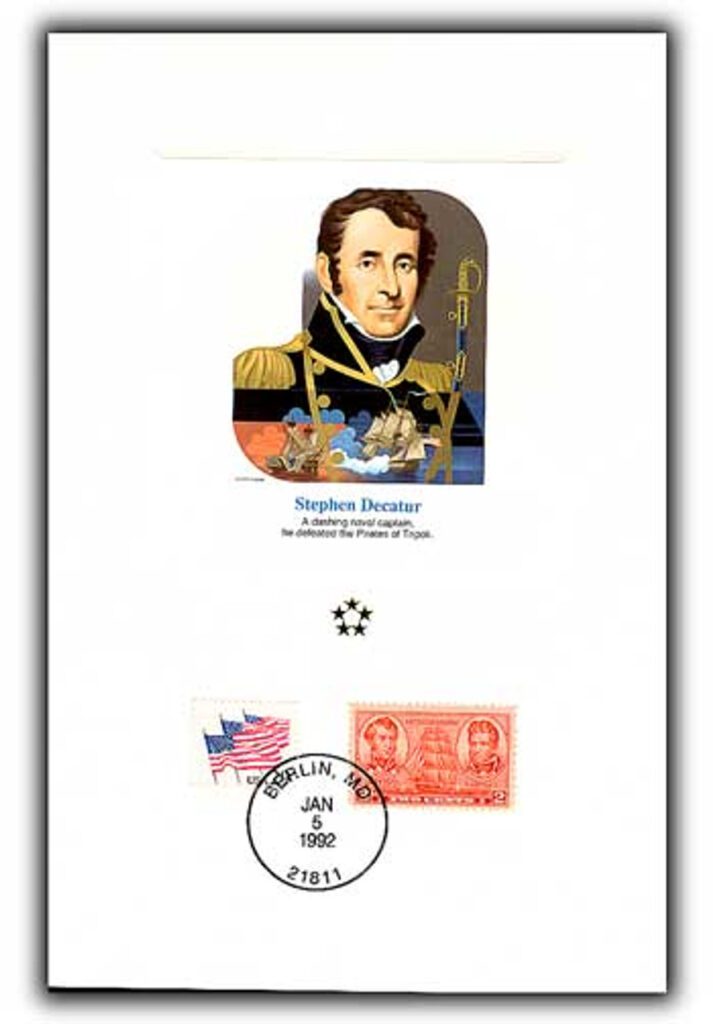
On February 16, 1804, Stephen Decatur led a surprise assault on the captured USS Philadelphia in Tripoli.
In the early 1800s, pirates from the Barbary states (Morocco, Algeria, Tunis, and Tripolitania) frequently raided US ships in the Mediterranean Sea. The sailors and their ship’s contents were often captured and then ransomed back to the US for a hefty price. President Thomas Jefferson sent the US Navy to the area to put an end to this in 1801, leading to a series of minor sea engagements that started the First Barbary War. Then, in June 1803, a small US expeditionary force attacked Tripoli harbor (in present-day Libya) and major fighting began.


That October, the US frigate Philadelphia ran aground near Tripoli harbor. The ship’s captain, William Bainbridge, attempted to get the ship back in the water by dumping cannons and other heavy cargo to make it lighter. When all attempts to free the ship failed, he ordered his crew to drill holes in the bottom of the vessel, dampen the gunpowder, and destroy anything else the enemy could find useful. They were captured shortly after.
Though the Philadelphia was badly damaged, it could still be repaired, or used as a model for new enemy ships. The Americans knew they couldn’t let the Tripolitans use the Philadelphia to their advantage, so Lieutenant Stephen Decatur led a mission to recapture or, as a last resort, destroy the Philadelphia.
Decatur’s daring actions began on the evening of February 16, 1804. Around 7:00 p.m., under the cover of darkness, Decatur led the Intrepid into Tripoli harbor, while leaving the Syren out to sea to provide supporting fire during and after the assault. Among the 80 volunteers Decatur brought with him was Thomas Macdonough Jr. (also pictured on US 791), who had previously served on the Philadelphia and knew its layout very well.
The Intrepid was disguised to look like a merchant ship from Malta with British colors. While most of the attackers hid in the lower deck, the men up top were Sicilian volunteers who spoke Arabic to avoid suspicion. Pretending to be in distress, they told the crew guarding the Philadelphia that they had lost all of their anchors at sea. The lie was believed, so they casually floated the Intrepid next to the Philadelphia and tied the ships together. Then Decatur shouted “board!” and the volunteers emerged from the Intrepid, attacking the surprised crew aboard the Philadelphia. Decatur’s men, dressed as Maltese and Arab sailors, carried swords and boarding pikes, and were ordered not to fire their guns unless absolutely necessary. Within 10 minutes, they killed 20 Tripolitans, captured one, and forced the rest to jump overboard. The Americans didn’t lose a single man and only suffered one injury.
Unfortunately, the Philadelphia was too badly damaged to set sail, and too large to be towed by the Intrepid, so Decatur ordered his men set it on fire. When they were done, Decatur was the last man to leave the Philadelphia. As the flames heated the Philadelphia’s loaded cannons, the unmanned ship began firing into the town. Shocked at what had happened, the Tripolitans gathered on the shore and filled small boats to fire on the escaping Americans. But with supporting fire from the Syren, Decatur and his crew escaped unscathed.
Decatur instantly became a national hero and was dubbed “Terror of the Foe.” British Vice Admiral Horatio Nelson described the attack as “the most bold and daring act of the age.”
Click here to see a dramatic painting of the burning of the Philadelphia.
| FREE printable This Day in History album pages Download a PDF of today’s article. Get a binder or other supplies to create your This Day in History album. |
Discover what else happened on This Day in History.




Exciting account. Thank-you!
What a great leader Stephen Decatur must have been. Thank you Mystic for today’s Article.
Stephen Decatur is buried in St. Peter’s Episcopal Cemetery, 313 Pine St, Philadelphia, PA. There is an impressive monument at the grave. His aporfents are buried there also. It is a quiet place unlike Captain Decatur’s naval career. Some of his family members were also naval men. See Findagrave.com
What are aporfents?
I grew up on Bainbridge Avenue in the Bronx Decatur Avenue was nearby. Few, if any of my neighbors knew the streets we lived on were named for early American naval heroes. Through my stamp collecting, I knew this as a young boy.